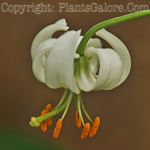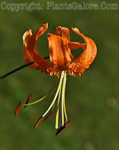 |
Horticultural Division 1. Asiatic
Hybrids. |
Derived from species native to
Asia, these
lilies are among the earliest to bloom in
the home landscape. They have a very broad
range of colors including White, Pink, Plum,
Yellow, Orange and Red. Flowers of this
division tend to be upward facing, outfacing
or pendant. Generally they do not have much
fragrance, if any.
Most of these cultivars are formed by cross
breeding species including
L. tigrinum, L. cemuum, L.
davidii, L. maximowiczii, L.x macultum, L.
x hollandicum, L. amabile, L. pumilum, L.
concolor, & L. bulbiferum.
|
 |
 |
 |
 |
 |
 |
 |
| 'Fire
King' |
Nasturtium-flame |
2-3 |
Stem |
Mid |
Outward-facing |
C LI OC |
|
Hariequin Hybrids |
Pink,
Red, Purple, Cream, Yellow |
3-4 |
Stem |
Mid |
Pendent |
C: LT: OC |
| 'Ma x will' |
Orange-Red |
5-6 |
Stem |
Mid-tate |
Pendent |
C LT OC |
|
Mid-Century Hybrids |
Yellow
to Maroon-Red |
2-4 |
Stem |
Early/mid |
Upright |
C LT OC |
| 'Marhan' |
Rich
Orange |
4-5 |
Stem |
Early/mid |
Pendent, Turk'scap |
|
| 'Mrs R. 0. Backhouse' |
Orange-Yellow |
4-5 |
Stem |
Early/mid |
Pendent, Turk'scap |
LT
PS |
|
 |
Horticultural Division 2. Martagon
Hybrids |
 These
lilies bloom early along with the Asiatic lilies
and have small, downward facing flowers. The
stems have whorls of leaves spaced along their
length. Martagons are considered shade tolerant
but will also thrive in the sun. They do well in
the same conditions as
hosta. It may take
several years for plants to become well
established in the garden due to their slow
growth rate. Flowers are most commonly Pink or
deep dark Red but cultivars also come in White,
Yellow, lavender, light Orange with dark
speckles and spots on the petals. These
lilies bloom early along with the Asiatic lilies
and have small, downward facing flowers. The
stems have whorls of leaves spaced along their
length. Martagons are considered shade tolerant
but will also thrive in the sun. They do well in
the same conditions as
hosta. It may take
several years for plants to become well
established in the garden due to their slow
growth rate. Flowers are most commonly Pink or
deep dark Red but cultivars also come in White,
Yellow, lavender, light Orange with dark
speckles and spots on the petals.
Lily cultivars in this group
are most commonly the result of crosses between
L. martagon, L. hansonii, L. medeoloides
&
L. tsingtauense.
|
 |
 |
 |
 |
 |
 |
 |
| Paisley Hybrids |
White to
Orange, Brown |
3-5) |
Stem |
Early
|
Pendent, Turk's-cap |
|
| candidum |
|
|
|
|
|
|
| Lthr,in x testaceupn |
Apricot
& Lilac spotted |
4-5 |
Base |
Mid-late |
Trumpet |
plant very shallowly |
|
 |
Horticultural Division 3. Candidum
Hybrids |
These are cultivars
of combinations of L. candidum, L. chalcedonicum,
L. monadelphum, & other species native to
Europe with the exclusion of L. martagon.
Only a few cultivars make up this division.
|
 |
 |
 |
 |
 |
 |
 |
| American Bellingham
Hybrids |
Yellow to
Orange-Red |
5-7 |
Base |
Mid Turk's-cap |
C N PS |
|
| Del None Hybrid |
Shades
of Pink |
5 |
Base |
Mid Turk's-cap |
C PS |
|
|
 |
Horticultural Division 4. American
Hybrids |
Northern North America has an
abundance of native lily species and many of
them have been crossed to produce a large group
of cultivars. The bulbs have jointed scales and
the blooms are borne up swinging, curved
pedicels. As their native environment would
indicate, these do best in cool summers and may
tolerate dappled shade.
Species commonly used
to develop these cultivars include L. pardalinum, L. humboldtii, L. kelloggii
&
L. parryii among others.
|
| |
 |
 |
 |
 |
 |
 |
 |
| Aurelian Black Magic |
Purple-Brown White
inside |
4-5 |
Stem |
Mid-late |
Funnel-shaped
|
LT PS |
| Golden
Clarion Strain |
Yellow
to Gold |
3-5 |
Stem |
Mid |
Funnel-shaped |
LT PS |
| Golden
splendor Strain |
Deep
Gold |
4-6 |
Stem |
Mid |
Funnel-shaped |
C PS |
|
 |
Horticultural Division 5. Longiflorum
Hybrids |
These cultivars come from a cross
of L. longiflorum & L. formosanum. Plants in this division have
White, trumpet
shaped flowers and they are not especially
hardy.
|
|
|
 |
Horticultural Division 6. Aurelian
Hybrids |
 Plants in this division are
characterized by large, waxy, trumpet shaped
flowers with a heavy fragrance. The most common
color is White but many cultivars are available
in Gold, Yellow, Chartreuse, Pink, Plum and
Apricot. These are mid to late season blooming
lilies. Plants in this division are
characterized by large, waxy, trumpet shaped
flowers with a heavy fragrance. The most common
color is White but many cultivars are available
in Gold, Yellow, Chartreuse, Pink, Plum and
Apricot. These are mid to late season blooming
lilies.
The species,
Lilium henryi, is
common in the breeding of these cultivars. It is
often combined with L. luecanthum, L. regale, L. sargentiae
& L. sulphureum.
|

|
 |
 |
 |
 |
 |
 |
| Golden Sunbnrst
Strain |
Golden-Yellow |
4-5 |
Stem
|
Mid-late |
Star-shaped |
C LT |
| 'Green Dragon |
Chartreuse-Green |
3-6 |
Stem |
Mid |
Funnel-shaped |
C |
| Heart's Desire
Strain |
White,
Cream, Yellow-Orange |
5-6 |
Stem |
Mid |
Pendent |
C LT PS |
| 'Limelight' |
Chartreuse-Yellow |
4-6 |
Stem |
Mid |
Funnel-shaped |
C LI PS |
| Olympic Hybrid |
Pink to
Green |
4-5 |
Stem |
Mid |
Trumpet |
C LT PS |
| Pink Perfection
Strain |
Violet
to Purple |
5-7 |
Stem
|
Mid |
Funnel-shaped |
C
PS |
|
 |
Horticultural Division 7. Oriental
Hybrids |
.jpg) This group of cultivars from
Asian species is particularly tolerant of hot
summer climates. The flowers are in shades of
White, Pink, salmon and crimson with most of
them being very fragrant. They like their "feet"
cool so cover the soil with mulch to keep them
happy. This group of cultivars from
Asian species is particularly tolerant of hot
summer climates. The flowers are in shades of
White, Pink, salmon and crimson with most of
them being very fragrant. They like their "feet"
cool so cover the soil with mulch to keep them
happy.
Species involved in the development of
these cultivars include L. auratum, L. speciosum,
L. nobilissimum, L. rubellum, L. alexandrae
& L. japonicum.
|
 |
 |
 |
 |
 |
 |
 |
| 'Bonfire' |
Crimson & White |
4-5 |
Stem |
Late |
Bowl-shaped |
C OC |
| Brandywine |
Orange |
3-4 |
Stem |
Early |
Outward-facing |
C LT OC |
| Fiesta Hybrids |
Yellow, Red, Orange |
3-5 |
Stem |
Mid |
Pendent |
C LT DC |
| Imperial Crimson
Strain |
Crimson & White |
4-5 |
Stem |
Late |
Flat-faced |
C |
| Imperial Gold Strain* |
White, Gold stripe |
4-5 |
Stem |
Late |
Flat-faced |
C |
| Jamboree Strain* |
Crimson & White |
4-5 |
Stem |
Late |
Recurved |
C OC |
| L. auratum* |
White & Gold |
4-7 |
Stem |
Late |
Open |
C PS OC |
| L. candidum* |
Satin-White |
3-4 |
Base |
Early/mid |
Chalice-like |
C LT |
| L. eemuum* |
Purple-Violet |
1-2 |
Stem |
Early/mid |
Reflexed |
UT OC R |
|
 |
Horticultural Division 8 Other Hybrids |
This division is made up of
cultivars not included in Horticultural Divisions
1 to 7 including crosses between divisions.
|
 |
 |
 |
 |
 |
 |
 |
| Orienpets Hybrids |
Cross
between Div 7 (Oriental) x Div 6
(Trumpet & Aurelian) |
|
 |
Horticultural Division 9. Lily Species |
To be a species, a plant must
be known to currently exist in the wild or there
must be evidence that it once existed in the
wild. Lily species come from many of the
temperate zones of the world including
North
America, Northern Europe and
Asia. Although may of the
lilies commonly grown in the home landscape
consist of cultivars, many of the species are also
available in the nursery trade.
|

|
 |
 |
 |
 |
 |
 |
| L. alexandrae |
|
|
|
|
|
|
| L. auratum |
|
|
|
|
|
|
|
L. bulbiferum |
|
|
|
|
|
|
|
L. candidum |
|
|
|
|
|
|
|
L. cemuum |
|
|
|
|
|
|
|
L. chalcedonicum |
|
|
|
|
|
|
|
L. concolor |
|
|
|
|
|
|
| L. davidii |
Cinnabar-md |
4-6 |
Stem |
Mid |
Turk's-cap |
C LT PS |
| L. formosanum |
|
|
|
|
|
|
| L. hansonii |
Golden-Yellow |
4 |
Stem |
Early |
Turk's-cap |
N PS |
| L. henryii |
Orange-Yellow |
7 |
Stem |
Late |
Recurved |
C
LT N PS |
|
L.
x hollandicum |
|
|
|
|
|
|
| L. humboldtii |
|
|
|
|
|
|
| L. japonicum |
|
|
|
|
|
|
| L. kelloggii |
|
|
|
|
|
|
| L. luecanthum |
|
|
|
|
|
|
| L. longiflorum |
Pure White |
2-3 |
Stem |
Early/mid |
Trumpet-shaped |
C LT OC |
|
L.
x macultum |
|
|
|
|
|
|
| L. martagon |
Purple or
purplish |
3-4 |
Base |
Early/mid |
Turk's-cap |
LT PS |
|
L. medeoloides |
|
|
|
|
|
|
|
L. maximowiczii |
|
|
|
|
|
|
| L. monadelphum |
Yellow
sometimes spotted |
4-5 |
Stem |
Early |
Pendent, Turk's-cap |
Li PS |
| L. nobilissimum |
|
|
|
|
|
|
| L. pardalinum |
Orange to
crimson |
4-5 |
Base |
Mid |
Turk's-cap |
C N PS |
| L. parryii |
|
|
|
|
|
|
| L. pumilum |
Scarlet |
1-2 |
Stem |
Early |
Turk's-cap |
C LT OC R |
| L. regale |
White earnune |
3-4 |
Stem |
Mid |
Funnel-shaped |
C N PS |
| L. rubellum |
|
|
|
|
|
|
| L. sargentiae |
|
|
|
|
|
|
| L. speciosum |
White to
crimson |
3-5 |
Stem |
Late |
Turk's-cap |
C N OC PS |
| L. sulphureum |
|
|
|
|
|
|
| L. tigrinum |
Lemon to
Orange
some spotted forms |
4-5 |
Stem |
Late |
Turk's-cap |
C LT N PS |
|
L. tsingtauense |
|
|
|
|
|
|
|
|
* |
Fragrant variety |
|
Seasons: |
Early = late spring to early summer
Mid
= midsummer
Late = late summer to early autumn |
|
Comments: |
C = suitable for cutting
ET = lime-tolerant
N = suitable for naturalizing
OC = suitable for outdoor containers
PS = likes partial shade
R = suitable for
rock gardens |
|